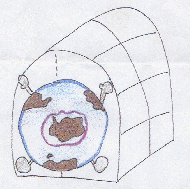|
This is the hottest century of the last six hundred years because there are a lot of gases in the atmosphere. These gases are forming a layer in the atmosphere which prevents the heat from escaping the Earth. It causes a warming of the planet, because of the green house effect. |
The gas responsible for the
climate changes is water steam. Another gas is CO2,
produced by the burning of coal and natural gas. Another one is methane,
produced by fermentations of organic wastes. And also N2O
(Nitrose Oxide) produced by the destruction of wastes and the use of fertilisers.
And finally, CFC (Chlorofluorcarbon), produced by aerosols, fridges and
air conditioning devices.
 |
| If
the planet temperature increases, more bacterium, germs, spores and other
illness carriers can survive.
In the 21st century, the temperature may increase 3.5ºC and a consequence of this fact is that the glacial areas will melt and the sea levels will rise between 50 and 95 cm. This fact will affect some coastal zones like the Mekang delta, 300 Pacific Islands,... It will also cause avalanches, terrain erodes and big changes in the rivers' flow. As well as floods, droughts, hot waves and forest fires. |
If the climate changes,
there will be more precipitations in some areas of the planet while in
other areas there will be less.
This change may cause biodiversity alterations and human and animal migrations.  |

